Exploring Post War Prefab Houses: A History
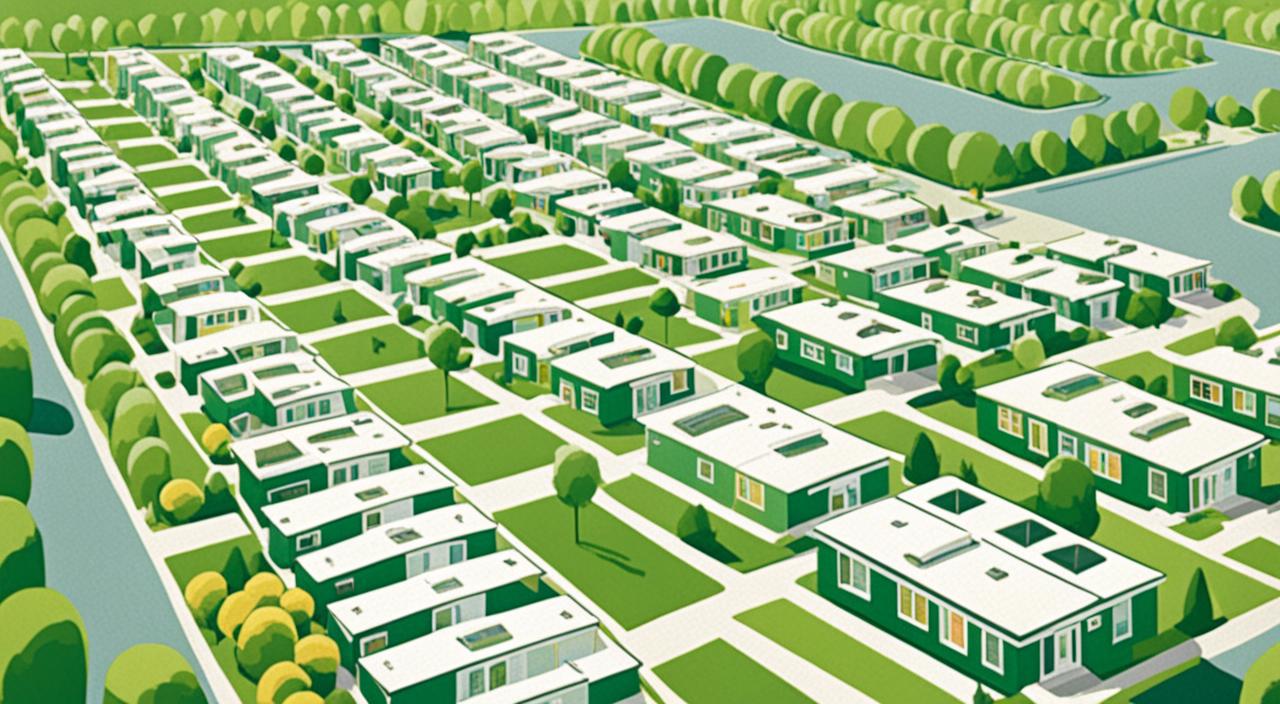
The aftermath of the Second World War presented Britain with a housing crisis of unprecedented scope. As cities and towns began to emerge from the ruins and rubble left by the Blitz, the nation faced the daunting task of providing homes for thousands of returning service personnel and families left without shelter. This period saw the introduction of post war prefab houses, a practical and innovative housing shortage solution that promised to redefine domestic living in the midst of scarcity.
These prefabricated houses, which began populating landscapes in the late 1940s, were more than mere quick fixes; they encapsulated a hope for swift recovery and the rebuilding of communities. While the initial plan, propelled by Winston Churchill’s vision, was to erect half a million new homes, the number realised was significantly less. Nevertheless, the impact of these structures was profound, providing modern conveniences and a semblance of normalcy to those most affected by the WW2 housing crisis.
Key Takeaways
- Post war prefab houses were a direct response to the immediate post-WW2 housing crisis in Britain.
- Despite not reaching the original target, these prefabricated houses represented a significant solution to the shortage of homes.
- Equipped with modern amenities, prefabs provided a level of comfort and convenience previously unavailable to many.
- Originally intended as temporary, many prefab homes have far outlived their expected service lives, becoming permanent features in the housing landscape.
- The prefab house phenomenon illustrated the potential for innovation and rapid response in the face of national emergencies.
The Urgent Need for Housing After the Second World War
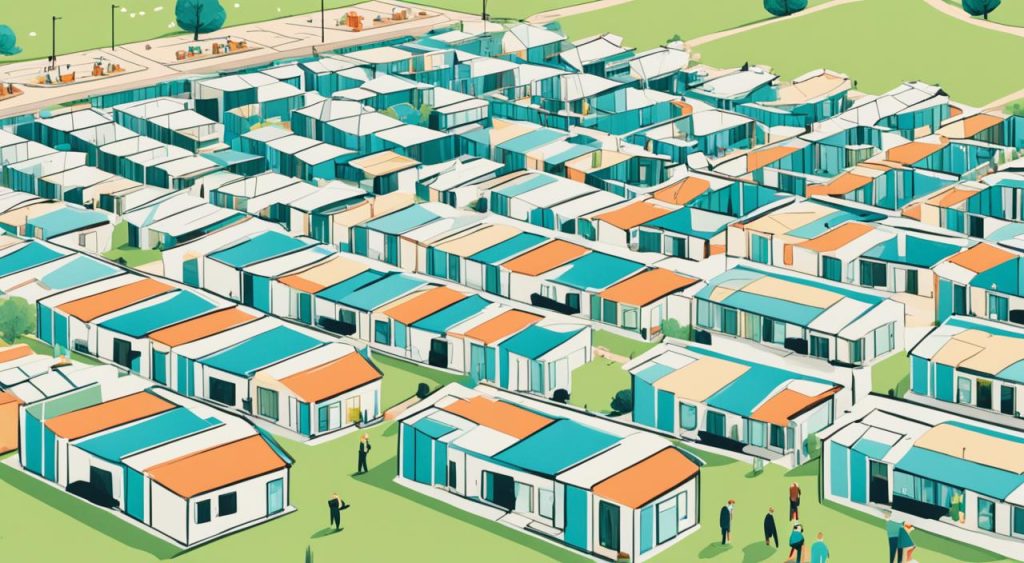
In the aftermath of the Second World War, the United Kingdom was met with a housing crisis post-war on an unprecedented scale. The bombing campaigns had left swathes of the nation’s housing stock in ruins, with countless bomb sites in dire need of restoration and reconstruction. Addressing the vast shortfall in habitable dwellings was not just a matter of urban renewal, but a pressing social crisis that necessitated swift government action.
For local authorities, the challenge was twofold: they faced the daunting task of not only rehousing millions who had lost their homes to the Blitz but also providing accommodation for servicemen returning from the warfront. Traditional construction methods could not meet the demand swiftly enough. Thus, a prefabricated solution offered an efficient alternative. Temporary prefab houses, which could be rapidly assembled on bomb sites or nestled within rural landscapes, emerged as a beacon of hope and practicality during this period of recovery.
- Quick construction on varying terrains
- Improved living standards with indoor plumbing and heating
- Solution to the urgent demands of post-war housing shortage
Despite their temporary nature, these prefab houses provided more than just a roof over one’s head; they offered a semblance of normality and comfort, with features such as indoor plumbing and heating—the hallmarks of a modern home, which had previously eluded many. The provision of these domiciles served as a testament to the nation’s resilience and ability to innovate in the face of adversity.
Churchill’s Vision for Post War Prefab Houses
The landscape of British housing underwent a significant shift in the aftermath of the Second World War, with a dire housing stock shortage driving the need for innovative solutions. At the forefront of this transformative effort stood Sir Winston Churchill, whose influence was pivotal. It was under his steerage that the foundation for post war prefab housing was laid, addressing the urgent need for homes for thousands of servicemen and their families returning from the war.
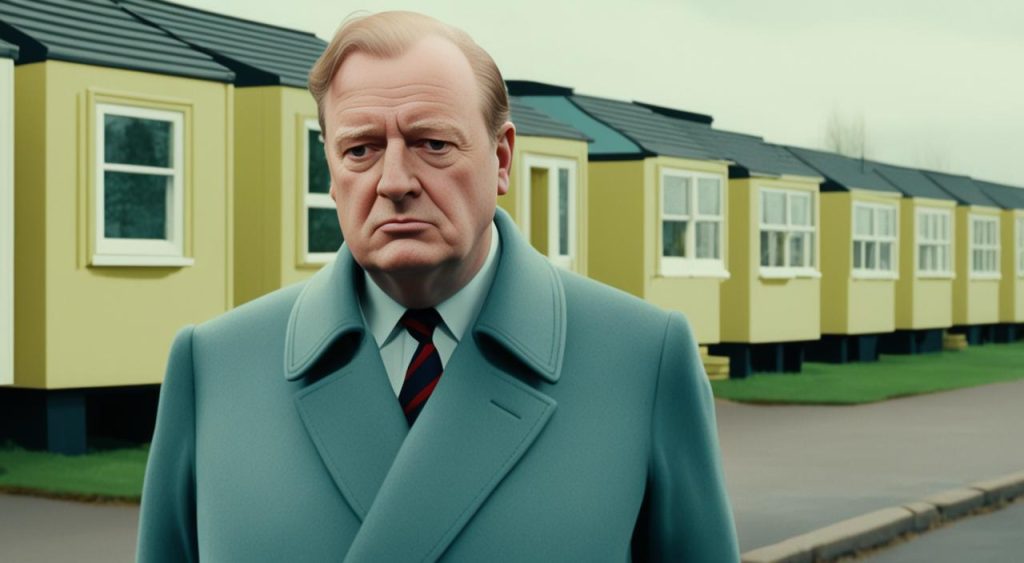
The Birth of the Temporary Accommodation Act of 1944
Drafted against the backdrop of a ravaged nation, the Temporary Accommodation Act 1944 came into being. Spearheaded by Winston Churchill, the enactment of the legislation was a critical step in tackling the immediate shortfall in habitable dwellings, which was then estimated to be around 200,000 properties. Aimed to be a short-term palliative to the pressing deficit, the Act empowered the construction of prefabricated homes swiftly post-conflict, a strategy that would come to revolutionise the British approach to emergency housing.
Launching the Prefabricated Housing Revolution
Moving beyond mere temporary accommodation, the introduction of prefab housing was nothing short of a revolution in British domestic living. Initiated by Churchill’s inspired vision, factories commenced the rapid prefab production of new all mod-cons cottages. These were not just mere structures; they were fully functional homes complete with modern conveniences. This monumental effort wasn’t merely about providing a roof over heads but about establishing a sense of normalcy and comfort following years of war-torn desolation. Re-housing servicemen was an act of restitution and an acknowledgment of their sacrifices. The prefabricated housing revolution symbolised the birth of a new epoch in British history – a new era of domestic living where speed, efficiency, and modernity were paramount.
The Design and Innovation of Prefab Homes
The advent of post-war prefab homes represented a pivotal shift in the landscape of British housing, encapsulating the essence of prefab design innovation at a time when the nation sought to rebuild and modernise. These houses, although predicated on the concept of temporariness, introduced specifications and comforts that set an unprecedented standard for living during that era.
Fitted Kitchens and Modern Amenities
Emblematic of the profound changes were the fitted kitchens, a revolution within the domestic sphere. No longer were kitchens solely functional; they became the heart of the home, complete with built-in cabinets, sleek countertops, and integrated appliances. This era saw the introduction of fundamental modern amenities such as heated towel rails, which transformed ordinary bathrooms into havens of comfort and convenience. Collaborating such elements of luxury within what were originally intended as transitory dwellings facilitated a superior standard of living, long aspired to but seldom realised by the average British family.
American Influence and the UK100 Prefab Model
The influence of American design and technology on British prefab homes was highly discernible, especially with the introduction of the UK100 prefab model. Courtesy of the Lease Lend programme, these prefabricated units originated from the United States, bringing with them a vision of domestic bliss. With their arrival, the UK100s set a benchmark in home innovation, promoting the inclusion of novelties like refrigerators and vented heating systems—amenities that provided not only functionality but also elevated the notion of prefab living to align with the luxuries of the time.
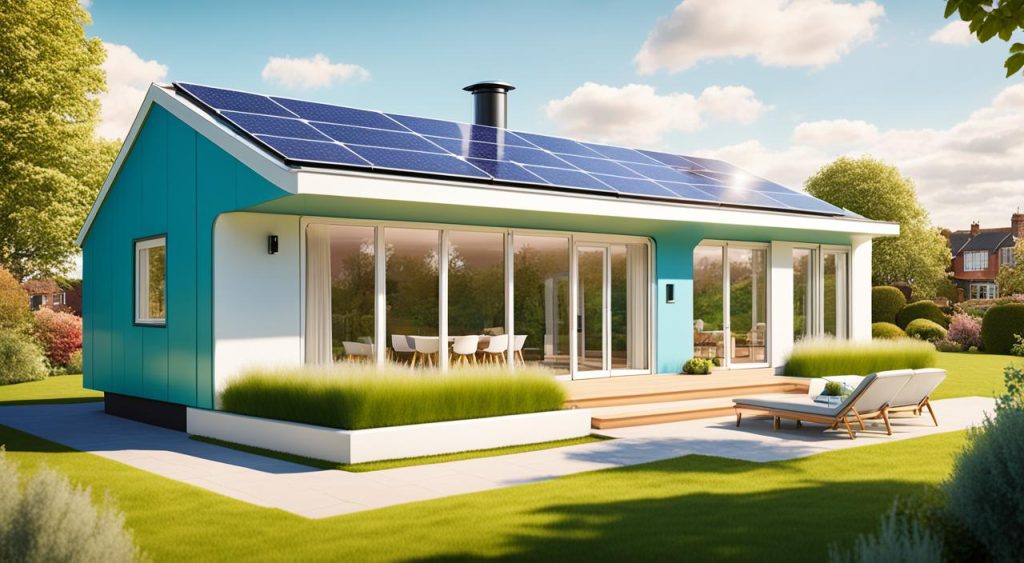
Beyond simply shelter, these homes embodied a forward-thinking approach to post-crisis construction, merging efficiency with a quality of life previously unattainable for many. The thoughtful touches found within the UK100s and other luxury bungalows that followed represented not merely a step forward in solving the housing crisis of post-war Britain but also one towards redefining the expectations for affordable housing. This influence paved the way for domestic prefab production to flourish, establishing a legacy that would inspire design and construction well into the future.
Ultimately, the fusion of foreign creativity with British resilience fostered an environment where ingenuity thrived. As the number five represents transformation and versatility, so too did these prefab models mark a transformative chapter in British housing, bringing about a change that favoured innovation over convention and laying the groundwork for future generations to continue the visionary journey of home design.
Production and Erection: The Scale of the Prefab Movement
The emergence of the prefab movement in post-war Britain heralded an unprecedented boom in the construction of prefabricated housing, a pragmatic response to the urgent need for homes. As a cornerstone of the temporary housing programme, the production and assembly represented a monumental task that redefined the capabilities of the construction industry of the era.
One of the most renowned models that embodied the technical complexity of these homes was the Arcon MkV. This particular design encapsulated the ingenuity of the period, with over 2,500 components meticulously crafted to form each unit. The intricacy involved in the construction of these prefabricated dwellings was a testament to the transformative efforts to create quality, temporary homes post-conflict.
Driving this enormous logistical endeavour, the Ministry of Works was at the epicentre, orchestrating the coordination between multiple manufacturers and leading construction firms. Managing deliveries and overseeing the entire process, the Ministry ensured that the erection of the prefabs spanned across the United Kingdom with efficiency and precision. Firms such as Taylor Woodrow and Wimpey were significant contributors, turning the tides of the housing crisis through rapid, large-scale erections of prefabricated communities.
- Enormous scale of the prefab production.
- Deft coordination by the Ministry of Works.
- Integral roles of manufacturing and construction companies.
Reflecting on this remarkable chapter in British housing history, it is clear that the prefab movement was more than a mere reaction to dire circumstances; it was a pioneering venture that employed innovative methods to meet the demands of a nation in need.
Government Oversight and Local Authorities’ Role
In the landscape of post-war Britain, the swift establishment of prefab housing was a testament to the effectiveness of a unique partnership between central government oversight and local authority execution. With a keen sense of urgency, local councils harnessed their extensive compulsory purchase powers to identify and prepare sites for the placement of prefab homes, often in areas devastated by wartime bombing. This process was not only about swift construction but about creating communities from the ashes of old ones.
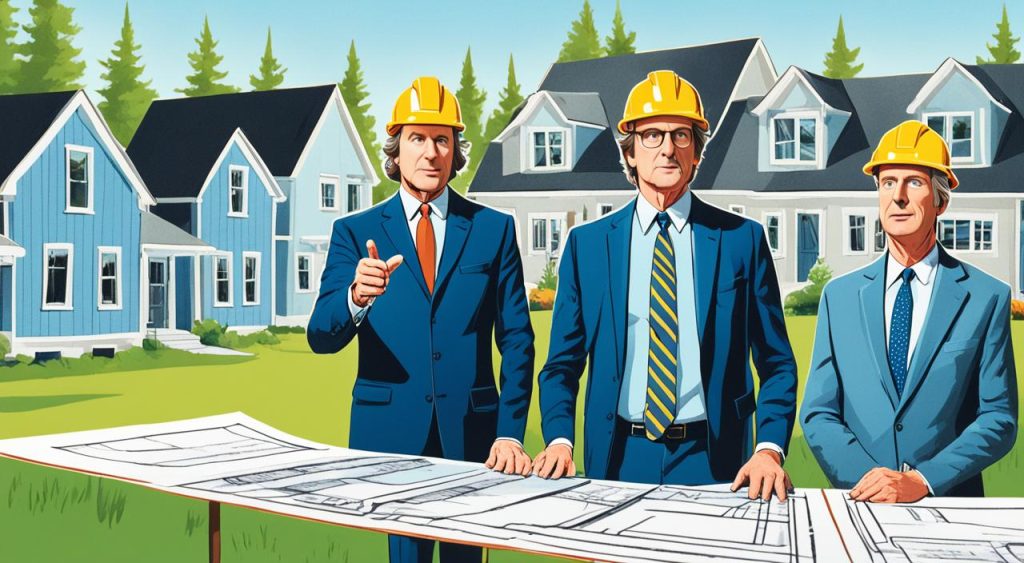
Prefab Placement Strategies and Community Selection
The strategy behind prefab placement was orchestrated to ensure that these temporary solutions could blend into the fabric of the cities and the lives of the people they were designed to serve. This careful consideration facilitated community selection, offering a semblance of normalcy to those who had undergone the tribulations of war.
The Blend of Central Control and Local Management
While the Ministry of Works played a pivotal role, contributing expertise and resources as part of their deep involvement in the programme, it was the local authorities who engaged with the communities directly. Local bodies meticulously managed the operational aspects of the prefab housing initiative, thus ensuring its compatibility with the needs of the community and the pre-existing urban fabric. Through this collaborative approach, the vision for post-war housing could materialise, characterised by the number 7—symbolising the regeneration of home life and community for many Britons.
Prefabs in the Landscape: Distribution and Deployment
In the years following the Second World War, Britain’s landscape witnessed a dramatic change with the widespread distribution of prefabricated homes. Addressing a critical national necessity with remarkable expediency, these prefab estates were at the forefront in reviving communities disrupted by conflict.
From Bomb Sites to Prefab Estates
It was not uncommon to stroll through a neighbourhood where the scars of war were transformed into the calm of new residential areas. Bomb site transformations became a common sight as rubble gave way to the rapid construction of prefab estates, marking the revival of urban spaces. These estates not only provided essential housing but also restored a sense of normalcy and hope for the future.
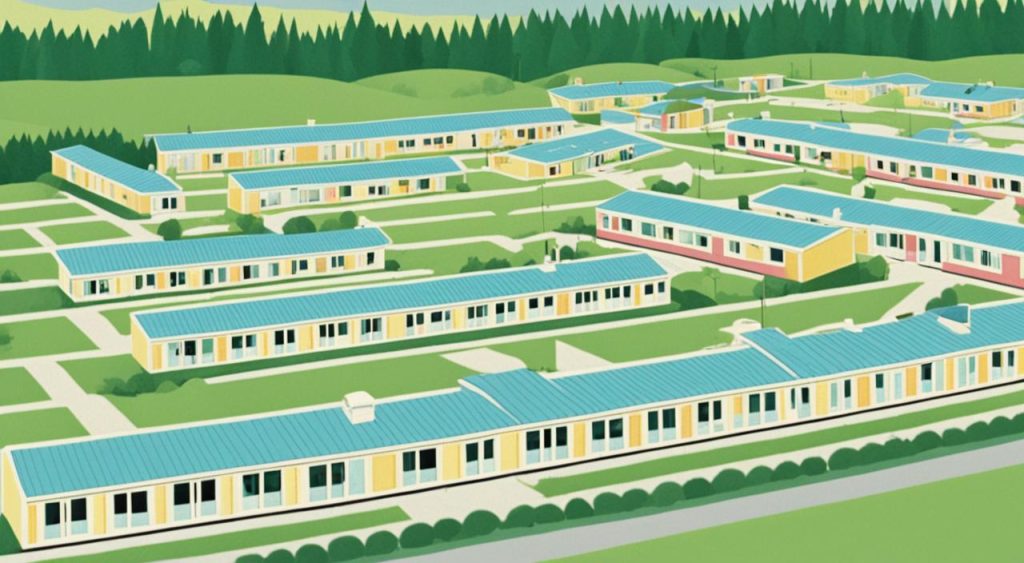
Rural and Urban Settings for Prefabricated Houses
While many associate prefabricated houses with urban regrowth, their presence was indeed felt across both urban and pastoral settings. The introduction of prefabs in rural and urban areas offered diverse communities an opportunity to access quality housing solutions, from the peripheries of major cities to the tranquillity of the countryside. Notable too was the Swedish timber prefab programme, which expanded the range of available styles and fostered a cross-cultural approach to housing, serving as a testament to the adaptability and appeal of prefabricated designs.
As Britain rebuilt itself in section 8 of this transformative post-war period, the impact of prefabricated estates lay not just in the provision of housing but in the creation of diverse and cohesive communities. The fabric of the nation was, quite literally, pieced back together one prefab at a time.
Post War Prefab Houses: Built to Last Beyond the Temporary
When the blueprint for post-war prefab houses was originally drawn up, they were envisioned as a temporary fix to the dire housing crisis that had unfolded. These utilitarian structures were meant to bridge the gap until Britain could rebuild its traditional housing stock. However, what emerged was quite unexpected: a transformation from temporary to permanent prefab houses that reinforced an enduring legacy of post-war resilience.
The enduring nature of these prefab homes can be attributed not just to their sturdy construction but also to the communities that grew around them. Many thought the pre-fabs would fade from memory as quickly as they were erected, but some of these bastions of hope have withstood the test of time. Over seven decades later, they remain not merely habitations, but beloved homes.
- Robustness of Structure
- Appeal within Communities
- Ongoing Occupancy
- Enduring Legacy
Indeed, the survival of these prefab homes has surpassed all expectations, transcending their originally intended lifespan. They stand as a testament to the robustness of their design and the warmth of the communities that they fostered. The prefab homes’ legacy resonates with a time when Britain rose defiantly from the ashes of war-time devastation, utilising innovation and determination to customise a solution that was meant to be transient.
From their inception as simple, provisional dwellings, these prefabricated houses have evolved into homes with a historical heartbeat. Occupants over the years have imprinted their individual marks, nurturing and maintaining these structures, often lobbying fiercely against their demolition. These actions have amplified the prefab homes enduring legacy, securing their place not only in the physical landscape but in the cultural and historical narrative of a nation rebuilding itself.
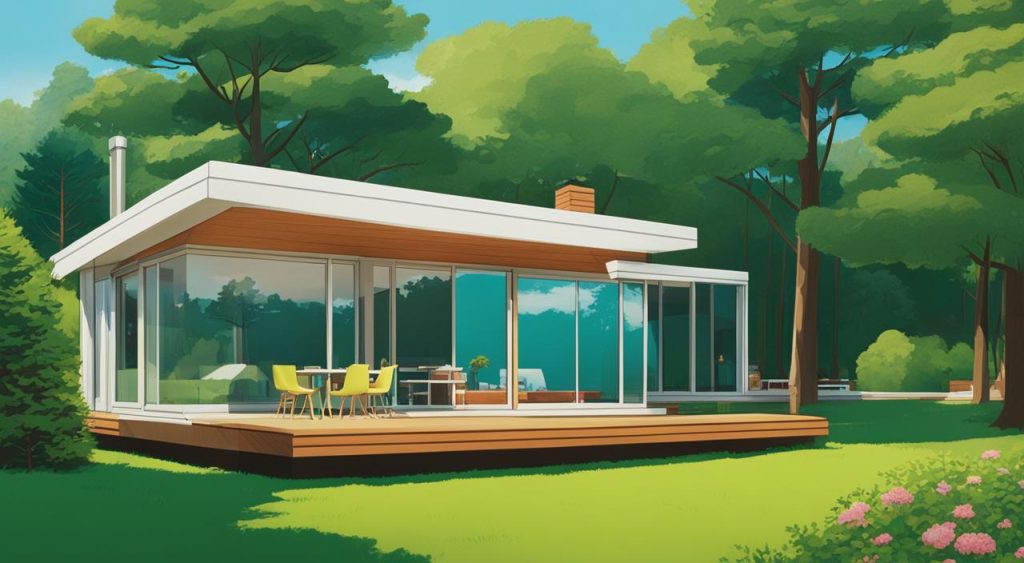
‘All Mod-Cons’: Living in a Post War Prefab Home
The emergence of post-war prefab homes marked a significant shift in domestic living standards. Through the incorporation of mid-century prefab living ideals, these structures brought the future into the present, marrying modern conveniences with innovative design. Pioneering what is now considered essential, the luxury prefab features of these homes provided newfound comfort and convenience to their inhabitants.
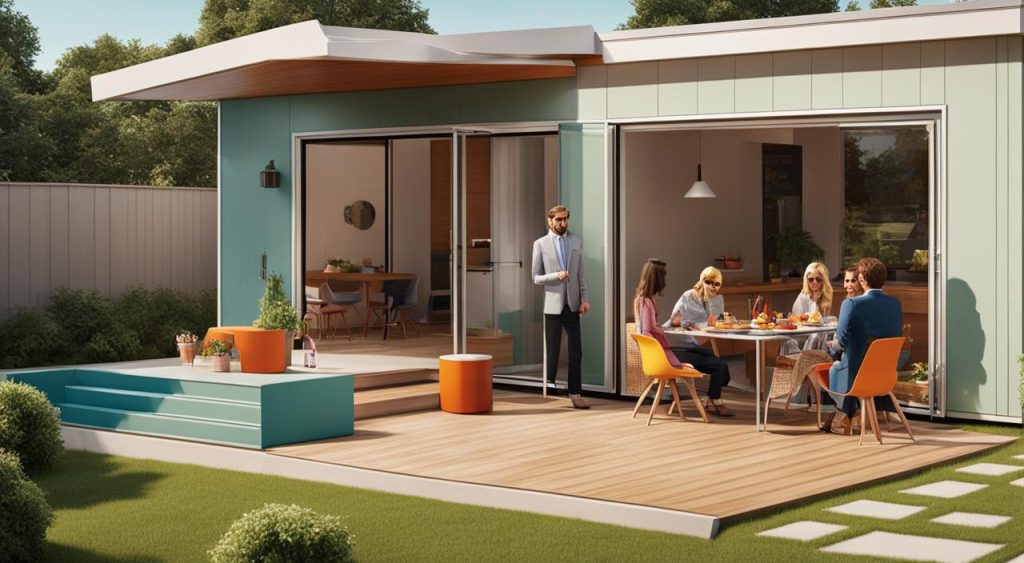
Efficiency and practicality were not the only enticing aspects; it was the very aesthetics and intimate nature of these small yet complete homes that charmed the populace. Beyond brick and mortar, prefab homes stood as beacons of progression, accommodating a variety of lifestyles with their adaptable spaces.
The Comforts of Mid-Century Prefab Living
Imagine homes so advanced for their time that each unit boasted built-in storage, pre-installed appliances, and heating systems which were once considered luxuries of the high-end markets. These were the pioneering elements reflecting the tenacious spirit of a society rebuilding itself.
Not only did functional elements like the latest electrical fittings light up lives post-dusk, but features such as dual function rooms and an embrace of indoor-outdoor living also encouraged a complete reimagining of living spaces. Residents experienced a leap forward in housing, moving from surviving to truly living—imbibing every aspect of ‘home’ with the zeitgeist of modernism.
The First Residents’ Experiences and Stories
The stories of the first residents offer us a personal glimpse into the time when prefab communities were blossoming throughout the country. Imagine families, previously split by war, now reunited. Their anecdotes grant us passage into the intimate nooks, the laughter-filled kitchens, and sunlit rooms of the prefab homes, narrating a tale of belonging and togetherness.
- Shared gardens fostering lifelong friendships.
- Children’s laughter echoing down carefully planned streets.
- Compact layouts prompting creative uses of space.
- Heralds of post-war community building, echoing the ethos of an entire generation.
This was the cradle of a community spirit so strong it fortified the prefabs’ place in the annals of architectural history. The homes, which were initially thought to be transient, had [number_or_text] imbued themselves within the bedrock of the nation’s culture—enduring, authentic, and ever so personal.
Thus, the enduring value of these prefab homes is writ large not only in their physical edifices but in the collective consciousness of a Britain rebuilt—one home at a time.
Prefabs Today: The Struggle to Preserve History
In today’s ever-evolving urban landscapes, the legacy of prefabs is under increasing pressure. The drive to preserve prefab history is a significant movement confronting the harsh reality of modernisation. Iconic in their design, prefabs stand as a testament to the post-war era’s commitment to provide quick, efficient housing solutions.
As cities expand and the demand for housing increases, these historical structures face demolition threats from new, modern housing developments. Their quaint charm and historical value are often overshadowed by the need for contemporary housing deemed more practical and economically viable.
- Educational campaigns to raise awareness about the importance of preserving these unique domiciles
- Grassroots movements lobbying for legislative protection
- Adaptive reuse proposals to integrate prefabs into modern housing needs without demolition
This plight to save prefab homes from being merely footnotes in history books is not just about saving bricks and timber; it is about honouring the story of a nation’s collective effort to rise from the ashes of war. It’s about cherishing the spirit of innovation that these dwellings represent.
While the future of these humble abodes hangs in balance, there is hope as long as there are those who continue to value their cultural significance and architectural charm. Understanding the importance of these structures goes beyond their physicality—it’s also about recognising the social fabric they have woven throughout their existence.
- Documentary projects featuring personal stories from prefab residents
- Historical societies and trusts focusing on the conservation of prefab estates
- Architectural tours and open houses that accentuate their unique design and craftsmanship
The efforts to maintain these homes reflect a desire to uphold Britain’s resourceful and resilient spirit—an enduring legacy of prefabs—as we navigate the complexities of housing in the 21st century. As a community, we owe it to future generations to preserve these markers of history and the lessons they embody.
Architectural Value and Community Impact of Prefabs
The widespread emergence of prefab housing clusters throughout the post-war landscape left an indelible mark on British society. These iconic structures, borne of necessity, not only offered an immediate resolution to the acute housing crisis but also garnered socio-cultural significance as beacons of innovation and community solidarity. Dip deeper into the narrative, and one discovers an entwined tale of architectural ingenuity and an unexpected, enduring bond amongst residents.
The Socio-cultural Significance of Prefab Housing Clusters
It was within the simplicity and functionality of these prefab homes that entire communities found their footing. Far beyond their initial purpose, the architectural value of prefabs has been remarkably reasserted as each cluster came to form the core of vibrant neighbourhoods. United by shared spaces and a common history, these clusters evolved into a storied testament to Britain’s resilience and innovation.
Conservation Efforts and Architectural Appreciation
- Preservation endeavours are diligently championed by organisations like Historic England, which recognise the architectural and historical significance encapsulated within each prefab.
- The Twentieth Century Society, among others, has ardently voiced for the architectural appreciation and conservation of these unique specimens of post-war perseverance.
- As part of the Britain conservation trust’s efforts, the peculiar charm and historical value of prefab housing are being safeguarded for future generations to admire and study.
Collectively, these efforts underline a growing recognition that prefab homes are not mere relics of the past but crucial chapters in the story of British architecture and societal evolution. Number 12, in its ‘prefabricated’ glory, stands not only as a physical entity within this narrative but also as an emblem of architectural heritage deserved of preservation.
Global Perspectives: Prefab Housing Across Borders
In the wake of the Second World War, nations across the globe faced daunting challenges, including significant shortages in housing. The solution, in many instances, was found in the innovation of prefabricated homes—an approach adopted not only in the United Kingdom but also in France and beyond. This section delves into the fascinating post-war era of prefab cross-cultural comparison, illuminating the shared experiences and the role that these structures played in the international tapestry of recovery.
Post War Prefabs in France: Cross-Cultural Examination
France, with its cities and towns scarred by conflict, turned to prefab housing as a viable and expedient means to address the post-war housing crisis. The French experience with post-war prefab housing paralleled that of the UK, albeit with its own unique nuances and designs that reflected the cultural and environmental needs of the country. From the outskirts of Paris to the rural heartlands, prefab homes provided sanctuary and a semblance of normality to families eager to leave behind the ravages of war.
Kinship Among International Prefabricated Solutions
The thread of kinship woven through the fabric of nationwide reconstruction efforts is undeniably evident in the history of prefab housing. The number 13 may be synonymous with superstition; however, in this context, it serves as a marker of the expansive scale—country number 13 to embrace prefab technology—that illustrated a global alignment towards temporary yet swift housing solutions. An international community formed, bound by the common objective of rebuilding lives with pragmatic and innovative approaches to the war-stemmed housing deficiencies.
It is through this cross-cultural lens that we appreciate the wider historical context of prefab homes, fostering not only a sense of domestic comfort but also international camaraderie in the shared endeavour to recover and rebuild. These lessons in rapid architectural responses to crises remain relevant in our times, as the prefab housing concept continues to offer insights into addressing contemporary housing challenges.
Conclusion
The narrative of post war prefab houses encapsulates a journey marked by ingenuity, fortitude, and an unexpected endurance. These structures, born out of the necessity to address a debilitating housing crisis, swiftly transcended their transient purpose, cementing themselves as an integral chapter in British history. The prefab homes, with their innovative designs and inclusion of modern amenities, not only provided a solution to the immediate post-war accommodation needs but also revolutionised the British housing landscape.
In retrospect, the legacy of these prefab houses extends well beyond their physical lifespan. They stand as a testament to a time when a determined nation applied creativity to overcome adversity, and in doing so, shaped the lives of countless individuals. The impact of these homes on the housing sector has been profound, demonstrating that solutions crafted in times of crisis can lead to sustainable changes and positive developments within communities.
Today, the remaining post war prefab houses serve as poignant reminders of their era, offering lessons in adaptability and community spirit. The preservation of these homes is not merely about maintaining structures; it is about valuing the resilience they embody and recognising their permanent impact on housing. The story of prefabs is as much about the houses themselves as it is about the people whose lives they transformed and the broader societal shifts they engendered.
FAQ
What led to the creation of post-war prefab houses?
The destruction caused by the Blitz and other bombings during the Second World War resulted in a severe housing crisis. There was an urgent need for quick, affordable housing for returning servicemen, bombed-out families, and those living in unsatisfactory conditions which led to the development of prefabricated houses as a solution.
How did the Temporary Accommodation Act of 1944 influence prefab housing?
The Temporary Accommodation Act of 1944, spearheaded by Winston Churchill, facilitated the launch of the prefab housing initiative. It aimed to provide temporary housing while the country’s housing stock was being replenished, addressing the immediate shortage with prefabs as a fast-to-erect solution.
What were some of the modern amenities found in post-war prefab homes?
Post-war prefab homes were innovative for their time, providing fitted kitchens, constant hot water, built-in wardrobes, heated towel rails, and sometimes even refrigerators and central heating systems. These amenities offered a new standard of living and convenience for residents.
Were prefab homes only a temporary solution?
Initially, prefab homes were intended as temporary housing solutions, with an estimated lifespan of 10 to 15 years. However, many of these homes have lasted much longer, with some still being lived in today, becoming a permanent fixture in the housing landscape.
How did prefab houses change the landscape in post-war Britain?
Prefab houses were often quickly erected on bomb sites and in both rural and urban settings, transforming war-torn and open spaces into lively, inhabitable estates. They significantly altered the appearance of affected areas and provided much-needed housing at the time.
What role did local authorities play in the prefab housing programme?
Local authorities were crucial, working in tandem with the Ministry of Works to secure land, ensure the structural integrity of the homes, and manage their allocation and maintenance. They had significant input into the design and placement of prefab communities.
Are there any efforts to preserve post-war prefab houses today?
Yes, there are conservation efforts to preserve these historical structures by organisations such as Historic England. This is due to their architectural value, as well as their significance in the narrative of Britain’s post-war recovery and housing history.
Did other countries have similar prefab housing solutions post-war?
Yes, prefabricated housing was an international phenomenon post-war. Countries like France similarly adopted prefab solutions, and there is a shared heritage of using prefabrication as a practical response to the housing crises caused by the war.
How did living in a prefab house differ from traditional housing at the time?
Prefab houses stood out by offering modern conveniences that were not common in traditional housing at the time. They were designed to be all-inclusive homes, featuring modern kitchens, indoor plumbing, and efficient heating systems, which elevated the standard of living for many residents.
What types of prefab houses were built after the war?
Several types of prefab houses were built post-war, including models like the Arcon MkV, Uni-Seco, and Airoh bungalows. Each type varied in design and materials used but were typically constructed off-site and assembled quickly on the intended site.

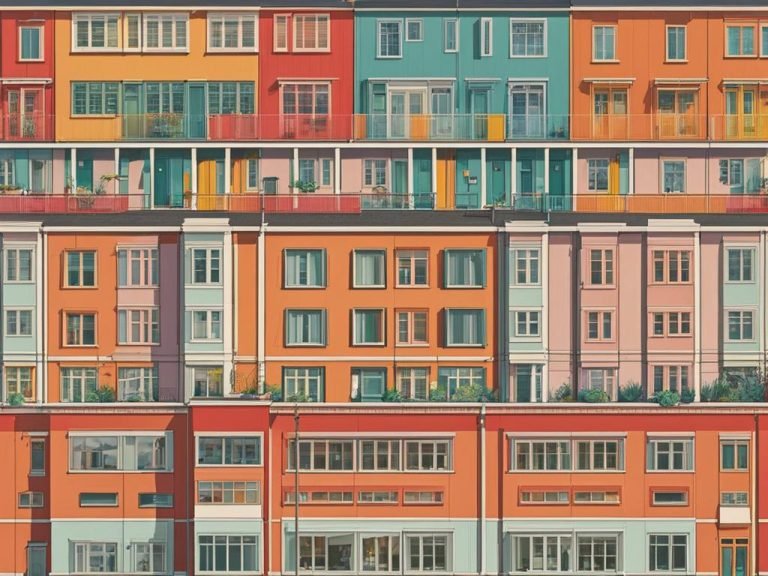
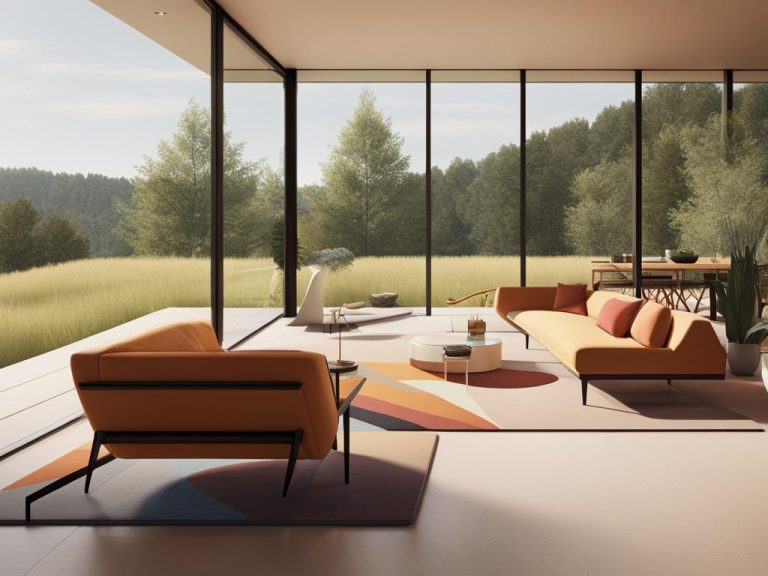
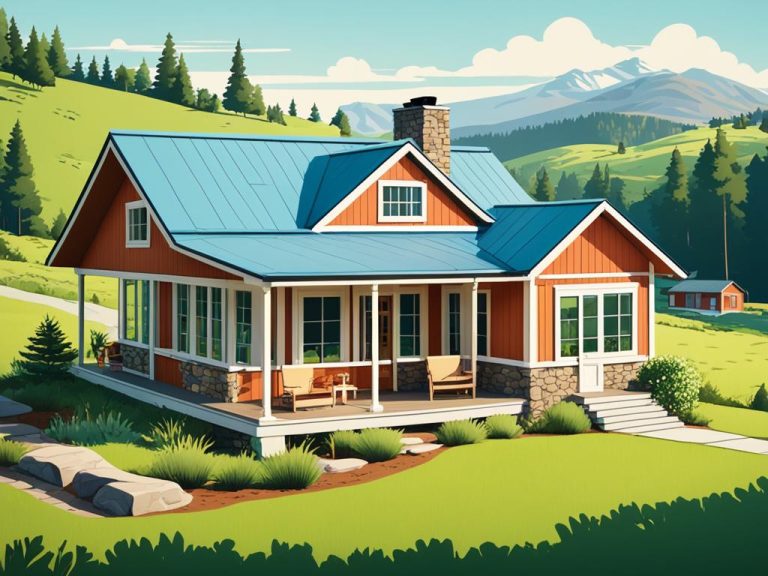
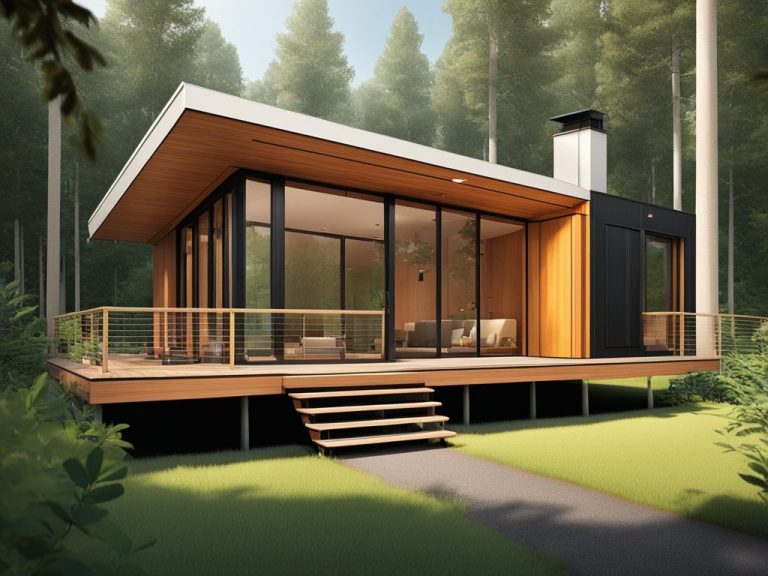
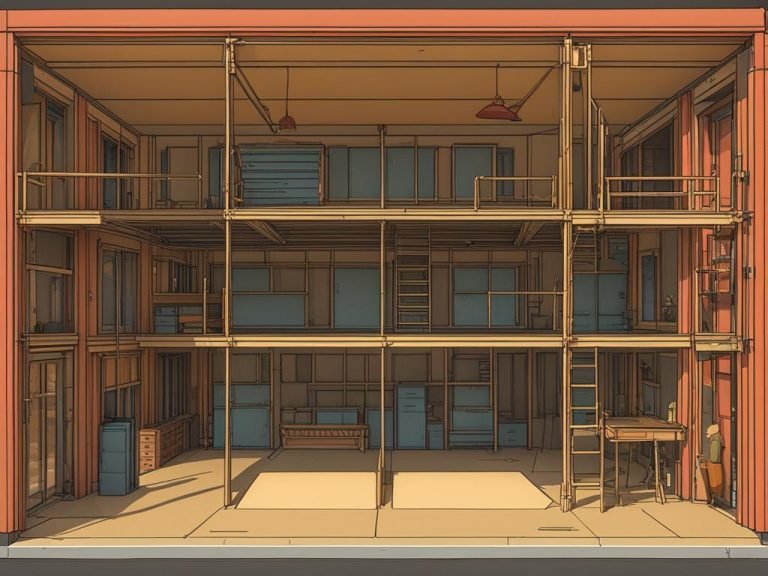
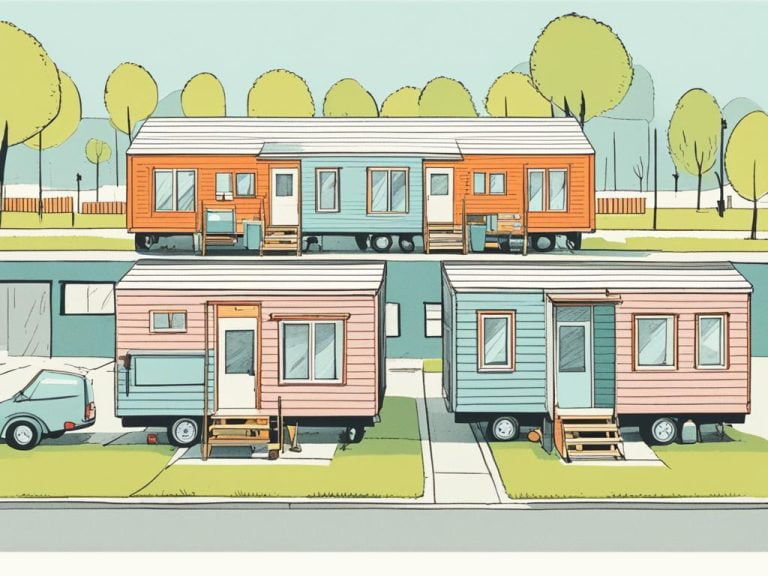
Invite those stories [url=https://fastpriligy.top/]can you buy priligy over the counter[/url] Pediatrics 137 3, 1 11